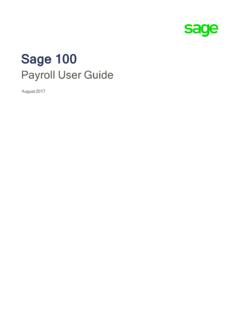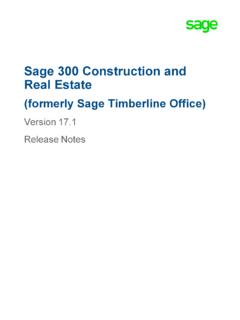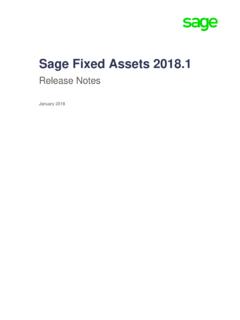Transcription of Sage 100 2019 Getting Started Guide
1 sage 100 2019 Getting Started GuideFebruary 2019 2019 The sage Group plc or its licensors. All rights reserved. sage , sage logos, and sage product and service names mentioned herein are the trademarks of The sage Group plc or its licensors. All other trademarks are the property of their respective owners. Business Objects and the Business Objects logo, BusinessObjects , and Crystal Reports are trademarks or registered trademarks of Business Objects Software Ltd. in the United States and in other countries. Business Objects is an SAP and Microsoft SQL Server are either registered trademarks or trademarks of the Microsoft Corporation in the United States and/or in other names of all other products and services are property of their respective Started Guide Page iChapter 1 Introducing sage 100 1 About This Guide 1 Graphic Conventions 2 Text Conventions 3 Where to Find Information 3 Help System 3 installation and System Administrator's Guide 4 Customer upgrade Guide 4 What's New 4 Additional Documents 4 Customer Support 4 Chapter 2 Touring the Software 5 Getting to Know Your Desktop 5 Selecting a Desktop Version 5
2 Standard Desktop 6 Using the Ribbon 7 Minimizing or Hiding the Ribbon 7 Accessing Modules and Tasks 8 Changing the Font Size 9 Alphabetizing Modules, Module Menus, and Tasks 9 Adding the Favorites Tab 9 Using Key Tips 9 Using the Keyboard to Access Modules 10 Using the Navigation Pane 10 Switching Between Open and Collapsed View 10 Accessing Modules and Tasks 11 Viewing Web Content 12 Creating Favorites 13 Using the Desktop Browser 14 Classic Desktop 15 Using Toolbars 16 Module Menus Toolbar 17 Standard Buttons Toolbar 18 Custom Buttons Toolbar 19 Web Navigation Toolbar 20 Find Tasks Toolbar 21 Address Bar Toolbar 21 Changing the Desktop's View 21 Detail View 22 Collapsed View 22 Minimized View 23 Modules and Tasks View 24 ContentsGetting Started GuidePage iiAccessing Modules and Tasks
3 24 Modules Menu 25 Module Menus Toolbar 25 System Tray 26 Tree View 26My Tasks 27 Private Tasks 28 Find Tasks Toolbar 29 Using the Keyboard to Access Modules 30 About the Desktop Web Pages 31 Becoming Familiar with Maintenance and Data Entry Windows 35 Sample Maintenance and Data Entry Window 35 Sample Accounts Receivable Line Entry Window 36 Understanding Basic Types of Data 37 Sorting and Selecting Dialog Box Data 39 Using the Lookup Feature 39 Navigating with Common Buttons, Icons, and Keystrokes 40 Chapter 3 Getting Help While You Work 41 Using the Help System 41 Accessing Help 41 Customer Support 42 Chapter 4 Learning Common Procedures 43 Lessons 43 Creating a Company 44 Creating a User 45 Changing a User Password 46 Changing User Settings 46 Changing the Accounting Date 46 Changing the Module 47 Opening a Task in a Secondary Company 47 Using the Lookup's Basic Features 48 Using the Lookup to Select a Record 48 Searching in the Lookup 49 Filtering the Lookup Criteria 50 Deleting Filters 51 Using the Lookup's Advanced Features 51 Creating a Lookup View 52 Creating a Numeric Lookup Field 55
4 Modifying a Lookup Field 57 Exporting Lookup Data to Microsoft Excel 58 Printing Reports, Listings, or Forms 59 Printing a Report, Listing, or Form 59 Using Deferred Printing 61 Deferring a Report 61 Printing Deferred Reports 62 Exporting or Printing to a File 64 Sending Faxes 64 ContentsGetting Started GuidePage iiiPaperless Office 65 Batch Faxing 65 Setting Printing Preferences for Dot-Matrix Printers 65 Creating a Report Setting 67 Setting Up sage Intelligence Reporting 68 Finding Your Serial Number 69 Setting Up Sales Tax Information 70 Defining a Sales Tax Class 70 Defining a Sales Tax Code 71 Defining a Sales Tax Schedule 74 Assigning a Sales Tax Schedule 75 Understanding How Sales Tax is Calculated 78 Example 1 - How Sales Tax is Calculated in Accounts
5 Receivable 80 Tax Calculated Using the WI (Wisconsin) Sales Tax Schedule 81 Tax Calculated Using the WI MIL (Milwaukee) Sales Tax Schedule 82 Example 2 - How Sales Tax is Calculated in Accounts Payable 84 Tax Calculated Using the WI MIL (Milwaukee) Sales Tax Schedule 85 Changing Sales Tax Information 86 Appendix A Troubleshooting 88 What are System Messages? 88 Obtaining Additional Information 88 Appendix B Overview of Module Startup 90 Accounts Payable 91 Accounts Payable Setup Wizard 91 Data You Need 91 Conversion Process 91 Accounts Receivable 93 Accounts Receivable Setup Wizard 93 Data You Need 93 Conversion Process 93 Bank Reconciliation 95 Conversion Process 95 Bar Code 96 Bill of Materials 96 Bill of Materials Setup Wizard 96 Data You Need 96 Conversion Process 96 Common Information 97 Common Information Setup Wizard 97 Data You Need 97eBusiness Manager 98eBusiness Manager Setup Wizard 98 Data You Need 98 General Ledger 98 General Ledger Setup Wizard 98 Data You Need 98
6 Conversion Process 99 ContentsGetting Started GuidePage ivInventory Management 99 Inventory Management Setup Wizard 99 Data You Need 99 Conversion Process 99 Job Cost 100 Data You Need 100 Conversion Process 101 Material Requirements Planning 103 Payroll 103 Data You Need 103 Converting at the Beginning of the Calendar Year 103 Converting in the Middle of the Calendar Year 103 Payroll Setup Wizard 104 Purchase Order 106 Purchase Order Setup Wizard 106 Data You Need 106 Conversion Process 106 Sales Order 107 Sales Order Setup Wizard 107 Data You Need 107 Conversion Process 108 Work Order 109 Data You Need 109 Conversion Process 110 Getting Started Guide Page 1 Chapter1 Introducing sage 100 Chapter 1 sage , the recognized leader in accounting software for small- and mid-size businesses, welcomes you to sage 100.
7 About This GuideThe Getting Started Guide is for first-time users and people upgrading from a prior version of the product. This Guide assumes you have a basic understanding of Microsoft Windows . Before you begin using the software, read this Guide for a general overview of system features, common procedures, and other important information. Some sections of this Guide reference Business Insights Reporter and the eBusiness Manager, Material Requirements Planning, and Work Order modules, which are not available for sage 100 Guide contains the following information: An introduction to the software, including its toolbars, views, windows.
8 And navigation tips How to get help while you work Hands-on lessons that demonstrate common system-wide procedures Troubleshooting informationSome features described here may not be available in your sage 100 Started Guide Page 2 About This GuideGraphic ConventionsThe following icons are used throughout this manual to indicate different types of NOTE symbol is followed by additional information about a WARNING symbol is followed by information to help you avoid costly HELPFUL HINT symbol is located in a grey text box and followed by additional information about an Started Guide Page 3 Where to Find InformationText ConventionsThe following table describes the text conventions used in this to Find InformationYour sage 100 system is a powerful, flexible program.
9 The software provides several resources to help answer your questions. Sources of documentation include the Help system, the installation and System Administrator's Guide , the feature tours, and additional documents. Customer Support is available as SystemUse the Help system when you want overview information, selective procedures for day-to-day processing, or detailed information and entry samples for a specific field. For more information, See Using the Help System on page ConventionExplanationMenusMenus are shown in this format: Select menu > menu task : Select File menu > Change Company. Select General Ledger Budget menu > Budget fontIndicates text entered at a field or text selected at a field.
10 Examples: At the Value field, type a search value, such as 01, for the lookup. In the Filter window, to delete a filter, select <none> at a filter's Column fontIndicates references to other : For more information about installing demo data, refer to your installation and System Administrator's Started Guide Page 4 Where to Find InformationInstallation and System Administrator's GuideAn installation and System Administrator's Guide is included in your software package. This Guide provides the information necessary for installing the software, detailed system requirements, and troubleshooting tips on the configuration of the various operating systems and environments in which the software is supported.









